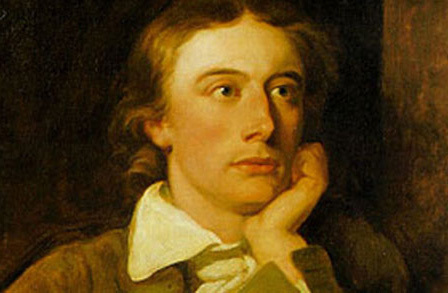About John Keats
John Keats belonged to the second generation of Romantic poets which included Lord Bryon and Percy Bysshe Shelly. Born in 1795, John Keats had a short lifespan in which he published 54 poems. His poems were not much praised during his lifetime, but posthumously they received good appreciation. His poems were first published when he was 21 years of age. His most notable works include “I Stood Tip-toe Upon a Little Hill”, “Sleep and Poetry”, and the famous sonnet “On First Looking into Chapman’s Homer”. In 1820, he published his third and best volume of poetry Lamia, Isabella, The Eve of St. Agnes, and Other Poems. It was in this collection that the three poems considered to be one of the finest among English language were included; Ode on a Grecian Urn, Ode on Melancholy and Ode to a Nightingale. John Keats died a young man at the age of 25 due to tuberculosis.
About La Belle Dame Sans Merci
La Belle Dame Sans Merci is a ballad. The title is taken from a French poem written by Alain Chartier in the 15th century. This poem was written in the year 1819.
Setting of La Belle Dame Sans Merci
There is no concrete setting in the poem. The knight-in-arms speaks of meadows and the speaker speaks of lakes and harvest. We can only assume that the setting is in some picturesque countryside place.
Poetic Devices in La Belle Dame Sans Merci
Stanza:
The poem is made of stanzas of 4 lines each.
Rhyme:
The rhyme scheme of all the stanzas is the same: ABCB.
Imagery:
There is some pretty vivid imagery in play throughout the poem. We can literally see the lady in front of her eyes, in all her glorious description. We can see hills, fields and flowers clearly too.
Allegory:
This poem is in the form of a story. There are many interpretations of this poem, making it both simple and complex. The hidden meanings inside it make it an allegory.
Similes:
The knight’s cheeks are compared to roses and the lady to a faery’s child. There are many other such similes.
Alliteration:
“She found me roots of relish sweet”; this is an example of alliteration in the poem. Another one is: “For sidelong would she bend, and sing a faery’s song.”
Irony:
The pretty lady and the knight seem to be in for a love ride. But it is soon shown that it was something else entirely.
Repetition:
The lines ‘O what can ail thee, knight-at-arms’ and ‘The sedge has withered from the lake,/ And no birds sing’ are repeated in the poem for effect.
Summary of La Belle Dame Sans Merci
The speaker of the poem sees a pale knight-in-arms in front of him. He asks the reason why he was so. The knight in arm tells his story. He speaks of a lady who was as beautiful as a fairy. They spend some good time together. The lady says that she loves the knight. Then she takes him to her place and there she lulls him to sleep. In his dreams, the knight sees kings and princes. They warn of him of a grave danger. When he wakes up from that dream, the knight sees that he is alone. His whole body has become feverish and his face pale.
This is the story the knight tells the speaker of the poem.
Analysis of La Belle Dame Sans Merci
The poem uses some complex form juggling between iambic pentameter and tetrameter to enhance the ballad-istic style. It starts with the speaker of the poem encountering a knight-at-arms, who was alone and pale. He asks him the reason. He is reminded of the sedge that had withered from the lake and of the muteness of birds. This paints a dreary picture.
The squirrel has food stored and the harvest was done; everything is good, but why are you so haggard and sad? asks the speaker. The speaker sees a wet lily on the knight’s brow; moist from anguish and covered in dew from fever. This says the state of the knight was feverish. And his color was fading fast just like that of a withering rose.
The knight then tells his story. He says he met a lady in the meadows (further proof of a landscape). She was beautiful like a fairy. He uses some vivid imagery to describe her in length. He made her some accessories like garlands and bracelets and the lady looked happy. This indicates of a budding romance in future.
The knight sits her on his horse and sees nothing but her all day as she song sweet and lovely songs. She gave him things to eat. Some comparisons are used to describe this food. And then she said in a strange language that she loved the knight. Now the strangeness of the language can be an indication of the different types of worlds they are from. This can be taken as foreshadowing for the following events.
The lady takes him to her home and there she cries and sighs. The reason for it is not given as of yet. The knight calms her. The lady then lulls the knight to sleep and there the knight dreams his ‘latest’ dream. This can indicate either of the following: that not much time has passed between the passage of these events and the meeting of the speaker; or that the knight could not sleep since.
The knight says he saw pale kings and princes and warriors. They warn him of ‘La Belle Dame sans Merci’, the lady without pity. They say the knight was in her trap. They were in the same state that the knight is when he meets the speaker of this poem. And when he awoke from that dream, he was on the same cold hill. There is no mention of what happened to the fairy-like lady.
There are some similarities between this story and that of Circe; a sorceress in Greek mythology who lured men and turned them into pigs. There is an indication of supernatural here. But nothing more is said of the lady.
The knight ends his story by saying that was the reason why he was alone and loitering in the state he was. He ends with the same lines the speaker uses in the beginning, to indicate the end of his story and the return to the present.
There is so much unsaid in this poem as seen from the above; no wonder it became an allegory. The ballad is in full swing from the start to the finish and the verse is both beautiful and regular.
Central Idea of La Belle Dame Sans Merci
There are many interpretations to the poem. Some say it has deep hidden meanings and continue delve deeper into the verse to find them. No wonder it is an allegory. But this poem can also be read as a simple story.
Tone of La Belle Dame Sans Merci
The tone of the poem is inquisitive at first. Then it becomes happy and reverential. Finally it becomes sad.
Conclusion
John Keats, typical of his poems, writes a ballad with a solid form and very sing-song verse, in which he tells a simple story of a knight and his encounter with a lady.
Contributor: Uttej Reddy
Some online learning platforms provide certifications, while others are designed to simply grow your skills in your personal and professional life. Including Masterclass and Coursera, here are our recommendations for the best online learning platforms you can sign up for today.
The 7 Best Online Learning Platforms of 2022
- Best Overall: Coursera
- Best for Niche Topics: Udemy
- Best for Creative Fields: Skillshare
- Best for Celebrity Lessons: MasterClass
- Best for STEM: EdX
- Best for Career Building: Udacity
- Best for Data Learning: Pluralsight













